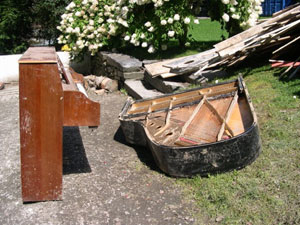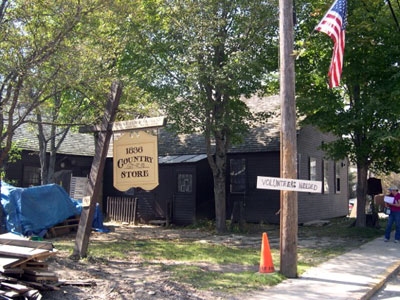 This Piano came from the famed Weston Playhouse in Weston, Vermont. It is Vermont’s oldest professional theater (est. 1935) and is a living testament to a community’s belief in the arts.
This Piano came from the famed Weston Playhouse in Weston, Vermont. It is Vermont’s oldest professional theater (est. 1935) and is a living testament to a community’s belief in the arts.On a snowy Valentine’s Day afternoon, more than a dozen people met at the Vermont History Center in the Vermont Historical Society building in Barre to talk about Vermont’s cultural emergency preparedness and response planning. The meeting was co-organized by Jackie Calder, Curator at the Vermont Historical Society, and Marty Reid, Vermont State Librarian. The purpose of the meeting was to have all organizations that are involved with emergency preparedness and response for cultural organizations discuss each organization’s plans to keep its constituencies involved and updated with emergency preparedness.
In addition to the organizers, attendees were from diverse organizations, including the Vermont Humanities Council, Preservation Trust of Vermont, Works On Paper, Vermont Arts Council, Vermont Council on Rural Development, Vermont State Archivist and Records Administration, independent paper conservationists, and the Vermont Division of Emergency Management & Homeland Security (DEMHS).
The historical landmarks, museums, art centers, and libraries represented by this diverse group are not the first organizations you think of as needing assistance or protection in times of emergency. However, some of them provide important human services, libraries for example, and others enable vital connections to our past that all communities want to see preserved and protected. Therefore, these organizations, like any other business or nonprofit organization, need to spend time on continuity planning and disaster preparedness.
Ben Rose, Recovery and Mitigation Section Chief at DEMHS, gave the attendees a lot of concrete advice to take back to their organizations, like: “When your beloved facility is flooded, lengthy plans on the shelf are not helpful. It’s the conversations in advance that have real value.”
Referring to Vermont’s Emergency Operations Plan, Rose said: “You will not find specific answers there about what you are supposed to do when there is a disaster. What it does is tell you that you have a role to play and who to call. Your call will reach the Emergency Operations Center – or EOC — and the people there will help you respond to your specific emergency.” Rose explained that the EOC is designed to take in information and respond in a flexible way.
He recommends that each organization have two things in preparation for future disasters: The first is to have a continuity of operations plan, and the second is to know where you fit into the incident command structure. For the continuity plan, he recommends that it literally fit on one piece of paper. And, on that one page should be up-to-date phone numbers for key contact people, including the Duty Officer hotline at the EOC: (800) 347-0488. Rose described having this phone number as “the most important thing you can take away from this meeting.”
Rose was clear to the meeting attendees. He noted that “you are taking the right step by having this conversation.” Marty Reid noted that “our organizations are not saving lives,” but Rose emphasized the importance of communication nonetheless. “When it doubt, I would rather you err on the side of having redundant information, than having missing information,” he said. “Use the ‘cc’ function on your email. Electrons are free! It’s always a good idea to copy your regional planning commission, your town clerk, and your local emergency management director on any communications you have during or after a disaster. Different organizations have different ideas about who needs to know what in a time of emergency. It’s better to communicate early and often and to let everyone know of your emergency.”
Rose also noted that in the event of a disaster, FEMA-eligible organizations have leeway in procurement for emergency response expenses incurred within the first 70 billable hours. Less documentation is needed during that time and FEMA gives you the benefit of the doubt. After that 70-hour emergency response window, FEMA requires proper competitive procurement.
 The 1836 Country Store was damaged by Tropical Storm Irene. It is in downtown Wilmington, a community that received intensive services from our grant.
The 1836 Country Store was damaged by Tropical Storm Irene. It is in downtown Wilmington, a community that received intensive services from our grant.Attendees were curious how cultural institutions can take advantage of hazard mitigation funding and also whether training qualified for reimbursement. It turns out that nonprofits and municipal entities, including libraries, may qualify for FEMA assistance. More information is available at the FEMA Disaster Assistance Policy (DAP) – 9521.3 (PNP) and the FEMA DAP 9521.1 – Community Center Eligibility.
Evidently, there is still a lot of hazard mitigation money available, but not for long. The window is still open for organizations to apply for this funding. The deadline is May 2 and to apply for the funds by that date, a letter of interest is due by April 1. Information about applying for Hazard Mitigation Grant funding can be found here.
If an organization does not qualify for FEMA Public Assistance funding for damages suffered in a disaster as outlined in the above policies, another possibility is to apply to the Vermont Disaster Relief Fund.
As you can see, the group learned a great deal of concrete information on how they can assist their facilities with disaster preparedness. Even more importantly, they made vital connections with similar organizations and agreed to meet on a regular basis so that both Vermont’s cultural institutions and artifacts will be better preserved for the future.
